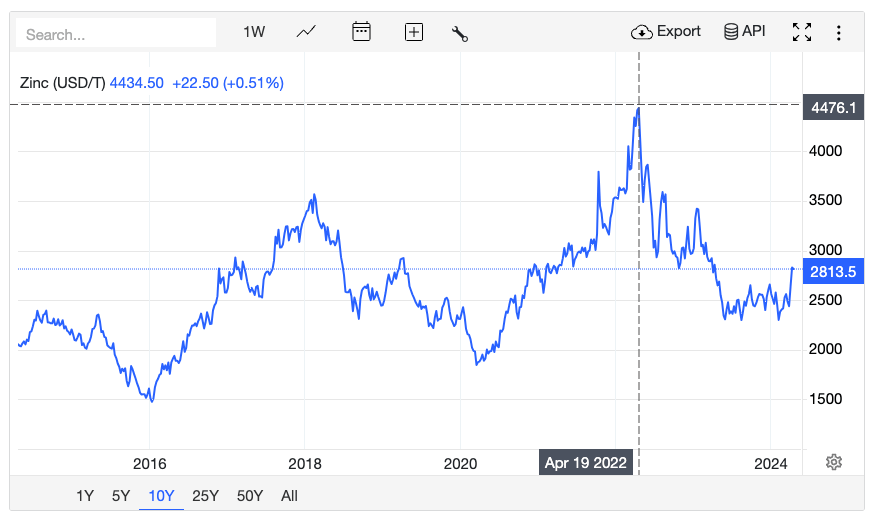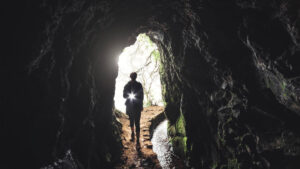Here’s why lower smelter prices spells opportunity for ASX zinc explorers

Pic via Getty Images
- Zinc prices have been in the doldrums in recent times but the tide is changing with lower smelter prices signalling a market shortfall
- Analysts say a 61,000t deficit is on the cards this year which means prices could surge higher
- If they do, aspiring miners like ZMI could be set to benefit
Zinc smelter prices have continued their downward slump this year, opening the doors of opportunity for explorers who were previously operating on fine margins.
During times of raw material surplus, smelter prices (the fee for converting concentrates into refined metal) tend to rise, but when they go down, it’s usually a tell-tale sign the market is in shortfall, and economic deposits can become very lucrative.
Analysts at Macquarie Bank are now betting on a 61,000t zinc supply deficit over this year while zinc prices continue their downward descent, lifting a mere 3% since the start of the year.
A series of mine closures have rattled the industry, starting with Boliden’s Tara mine in Ireland – the largest zinc mine in Europe and the fifth largest in the world – in June last year after prices of the galvanising metal hit a three-year low.
Nyrstar, an international producer of minerals and metals wholly owned by Trafigura, followed suit shortly thereafter with its plan to “temporarily pause operations” at the Middle Tennessee mine as well as suspending operations at the Budel zinc smelter due to the weak price environment.
Yet Zinc of Ireland (ASX:ZMI) managing director Tom Corr believes the zinc market could be in for a bull run of its own if smelting gate prices remain low.
Huge demand surge could send prices higher
The metal, often coined as ‘un-fashionable’ despite its growing role in supporting clean energy technologies like solar photovoltaic panels, wind turbines, and zinc air flow batteries, is primarily used for galvanising to protect steel from corrosion.
When zinc prices hovered around the US$3,500/t mark in 2017, companies had money in the bank to drill and build on their resources. It reached a peak of ~US$4,400/t in 2022 before quickly dropping back down to US$2,500/t, scaring investors away.

But it now seems like investors are catching on to the scramble.
“Zinc is primarily used in galvanising, whether it be your traditional applications or clean energy applications like electric vehicles and wind turbines,” Corr told Stockhead.
“You’ve also got zinc air flow batteries which Toyota are looking into, and while they aren’t currently produced at scale, they could prove to be a major source of growth going forward.”
Zinc air batteries are five times cheaper than lithium-ion batteries and are considered a safer and more stable option.
“There could be this huge demand surge out of left field and if that had to compete with conventional offtake for zinc, you’ll start to see the price go bananas because there simply isn’t much of the stuff coming out of the ground,” Corr adds.
Zinc or swim
ZMI’s Kildare project sits on the 40km-long Rathdowney Trend, one of the most prolific zinc belts in Ireland and possibly the whole of Europe, within a short distance of several profitable mines and major sulphide ore bodies owned by the likes of Canada’s largest mining giant Teck, Glencore, Vedanta and Boliden.
The company’s focus so far has been driven by Kildare’s similarities to the various high-grade mines nearby, including Canadian-listed Group Eleven Resources who boast Glencore as a 20% shareholder.
“Group Eleven recently made a new discovery called ‘Ballywire’ immediately next to our licences in Ireland, with their share price appreciating ~150% in the past 12 months, trading at a C$50m market cap,” Corr says.
“We’re currently carrying out a phased, trend-wide soil sampling program and we have a drilling program designed for Kildare once we decide to push the button.
“As the zinc market becomes more favourable, we’re more inclined to do that – it’s starting to feel like it’s the right time to get back out there and build on this 11Mt resource we already have at Kildare and also drill any regional targets that are generated along the way,” he adds.
Corr says there’s a few regional targets at Kildare which could be standalone deposits in their own right.
“The nature of these Irish-type deposits is they form in clusters, so while we’ve got one deposit at Kildare (with the belt also containing the famous Lisheen and Galmoy mines) there is plenty of room for future discoveries of significance especially, just look at Group Eleven’s new discovery,” he explains.
Dipping toes into germanium prospectivity
But its not just the zinc potential ZMI are excited about at Kildare.
A ‘Critical Element Study’ at the beginning of the year showed the potential for significant concentrations of germanium from all four key mineralised zones scattered throughout the project.
Results obtained from pXRF analyses on 906 samples within areas of previously identified zinc-lead mineralisation revealed samples of up to 433g/t germanium.
ZMI is now running a fine-toothed comb over 50km worth of historic drill cores that were never assayed for germanium.
“Having the bonus of the presence of elevated germanium at Kildare, we are optimistic that we can attract the right strategic partners and funding going forward, especially given the EU’s push to secure domestic supply of critical raw materials,” Corr says.
Zinc of Ireland (ASX:ZMI) share price today
At Stockhead we tell it like it is. While Zinc of Ireland is a Stockhead advertiser, it did not sponsor this article.
Related Topics
SUBSCRIBE
Get the latest breaking news and stocks straight to your inbox.
It's free. Unsubscribe whenever you want.
By proceeding, you confirm you understand that we handle personal information in accordance with our Privacy Policy.








